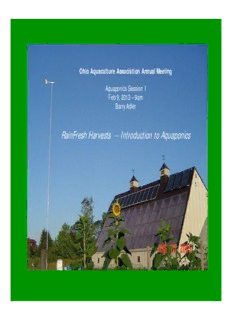
Introduction to Aquaponics - South Centers - The Ohio State University PDF
Preview Introduction to Aquaponics - South Centers - The Ohio State University
Ohio Aquaculture Association Annual Meeting Aquaponics Session I Feb 9, 2013 – 9am Barry Adler RainFresh Harvests --Introduction to Aquaponics Aquaculture The cultivation of freshwater and marine resources, both plant and animal, for human consumption or use. Aquaculture operations across the U.S. produce more than 100 species of aquatic organisms at different life stages, such as catfish, shrimp, salmon, scallops, oysters, and trout. Population is expected to grow by 50% in next 50 years Resulting in increased demand for limited natural resources to manufacture goods, provide energy and produce food Climate extremes will continue to disrupt traditional agricultural practices and yields Aquaculture will be an important part of the solution for growing food more efficiently moving forward Aquaculture Aquaculture or “fish farming” is one of the fastest growing segments within the agricultural sector worldwide. Aquaculture sales in Ohio have tripled from $1.8 million to $6.6 million in recent years. Source: 2010 Executive Summary Ohio Aquaculture Industry Analysis, Ohio Department of Agriculture, The Ohio State University South Centers Aquaculture In the last 20 years, the production of fish through aquaculture has grown exponentially, while marine fish catches have leveled off. Unless it’s an extraordinary year for marine fishing, in 2013 the lines will cross, and the majority of the fish we eat will come from aquaculture rather than oceans. Source: New York Times, January 24, 2013 Green Blog Energy and the Environment Aquaculture Opportunity Feed conversion rates for several aquaculture fish species are approaching 1:1, meaning that for every pound of feed, a fish gains one pound. By comparison, the most efficient farmed animals on land are broiler chickens with a 1.6:1 feed conversion ratio. Source: New York Times, January 24, 2013 Green Blog Energy and the Environment Aquaculture Challenges •Fish wastes, effluents and pollution •High capital investment /production costs •Need for infrastructure and technical support Aquaponics The combined culture of fish and plants in a closed, recirculating system Aquaponics CycleCredit:Radio Netherlands Worldwide Basic Aquaponics Goal Optimize growing conditions and yields for both plants and fish •Water quality Oxygen Fish wastes -- bio-solids and NH -N 4 •Fish density and feeding rates •Water, nutrients, proper temperatures and lighting for plants •Control pests in plants and fish tanks Harvest fish and plants in a manner that preserves quality and food safety
Description: